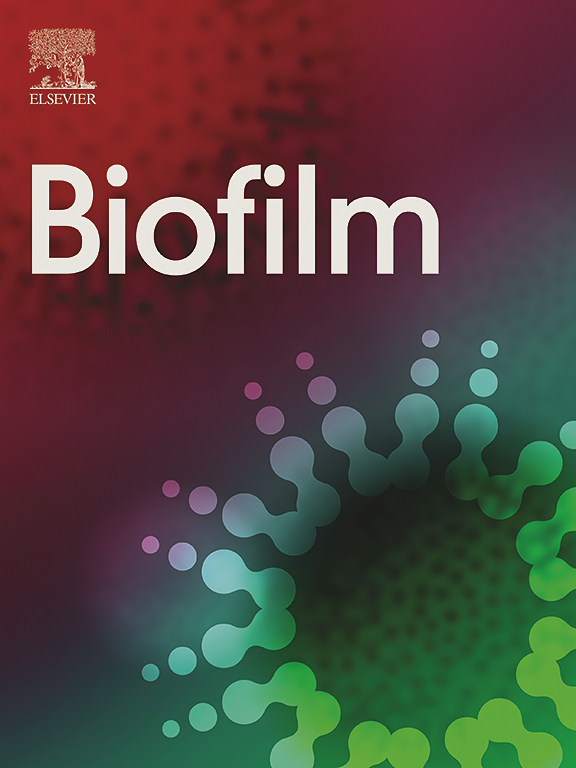A novel MIR imaging approach for precise detection of S. epidermidis biofilms in seconds
IF 4.9
Q1 MICROBIOLOGY
引用次数: 0
Abstract
The impact of microbial biofilm growth poses a threat to both human health and the performance of industrial systems, manifesting as a global crisis with noteworthy economic implications for modern society. Exploring new methods and alternative approaches for the detection of biofilm signatures are imperative for developing optimized and cost-effective strategies that can help to identify early-stage biofilm formation. Clinical diagnostic technologies are constantly looking for more affordable, practical and faster methods of prevention and detection of chronic infections in periprosthetic joint infections (PJIs), which are often characterized by biofilm formation on implant surfaces. Staphylococcus epidermidis (SE) is especially known for its strong biofilm production and is considered a leading cause of biomaterial-associated infections, including PJIs. Implant-associated infections are severe and difficult to treat, therefore it is crucial to continue identifying bacterial biomarkers that contribute to its structural stability and attachment to implant surfaces. This study presents a pioneering approach for fast spectral detection of biofilm formation with a novel mid-infrared (MIR) scanning system. To highlight the advantages of our MIR system, we performed a comparative analysis with measurements from a commercially available Fourier-transform infrared (FTIR) scanner. We have assessed SE biofilms grown for 3 days comparing the processing times between a commercially available infrared (IR) scanning system (∼8 h/cm2), and our innovative scanning approach with rapid self-built MIR detection, achieving a reduction in scanning time to seconds. K-means clustering analysis identified pronounced differences in distribution of clusters, representing a significant variation between biofilm producing (RP62A) and non-biofilm producing (ATCC 12228) bacterial strains. The distribution serves as a critical tool for identifying biofilm phenotypes, particularly where poly-N-acetylglucosamine (PNAG), a key constituent of extracellular polymeric substances (EPS) in S. epidermidis, represents the dominant mass fraction in the samples analyzed by our infrared (IR) scanning systems. In addition to faster processing times, our novel MIR system demonstrated significantly higher sensitivity compared to FTIR, enabling clear differentiation between the chemical signatures of biofilm and planktonic strains. The corresponding novel approach integrates advanced data analytics with a newly designed rapid MIR prototype, enabling optimized and swift detection of biofilm signatures. These signatures, now recognized as critical targets in diagnosing complex infections, provide an alternative to traditional microbial detection methods in clinical diagnostics.
一种在数秒内精确检测表皮葡萄球菌生物膜的新型MIR成像方法
微生物生物膜生长的影响对人类健康和工业系统的性能构成威胁,表现为对现代社会具有显著经济影响的全球危机。探索检测生物膜特征的新方法和替代方法对于开发优化和具有成本效益的策略至关重要,这些策略可以帮助识别早期生物膜的形成。临床诊断技术一直在寻找更经济、实用和更快的方法来预防和检测假体周围关节感染(PJIs)中的慢性感染,PJIs通常以种植体表面形成生物膜为特征。表皮葡萄球菌(SE)尤其以其强大的生物膜生成而闻名,被认为是生物材料相关感染的主要原因,包括PJIs。种植体相关感染严重且难以治疗,因此继续鉴定有助于其结构稳定性和附着于种植体表面的细菌生物标志物至关重要。本研究提出了一种新颖的中红外(MIR)扫描系统快速光谱检测生物膜形成的开创性方法。为了突出MIR系统的优势,我们与市售的傅里叶变换红外(FTIR)扫描仪的测量结果进行了比较分析。我们对生长3天的SE生物膜进行了评估,比较了市售红外(IR)扫描系统(~ 8 h/cm2)和我们采用快速自建MIR检测的创新扫描方法之间的处理时间,将扫描时间缩短到几秒钟。K-means聚类分析发现,产生生物膜的菌株(RP62A)和不产生生物膜的菌株(ATCC 12228)在簇的分布上存在显著差异。该分布是鉴定生物膜表型的关键工具,特别是表皮葡萄球菌细胞外聚合物(EPS)的关键成分聚n -乙酰氨基葡萄糖(PNAG)在我们的红外(IR)扫描系统分析的样品中占主导质量分数。除了更快的处理时间外,与FTIR相比,我们的新型MIR系统显示出更高的灵敏度,能够明确区分生物膜和浮游菌株的化学特征。相应的新方法将先进的数据分析与新设计的快速MIR原型相结合,能够优化和快速检测生物膜特征。这些特征现在被认为是诊断复杂感染的关键靶点,为临床诊断提供了传统微生物检测方法的替代方法。
本文章由计算机程序翻译,如有差异,请以英文原文为准。
求助全文
约1分钟内获得全文
求助全文

 求助内容:
求助内容: 应助结果提醒方式:
应助结果提醒方式:


